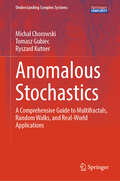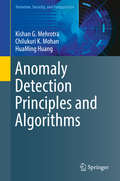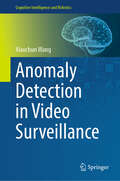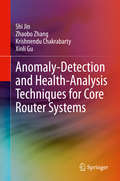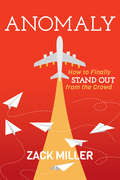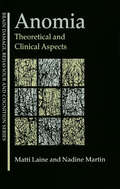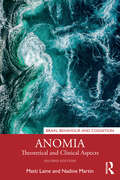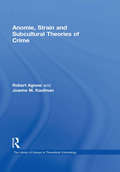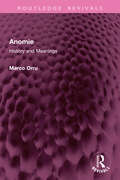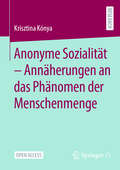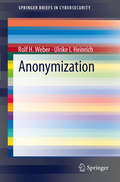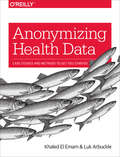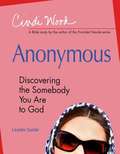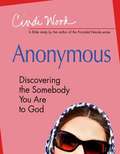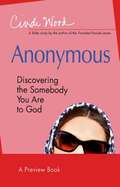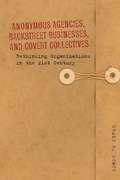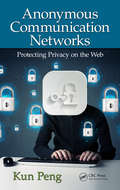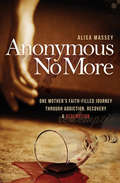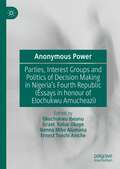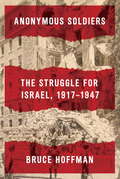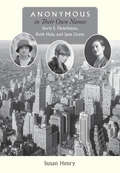- Table View
- List View
Anomalous Stochastics: A Comprehensive Guide to Multifractals, Random Walks, and Real-World Applications (Understanding Complex Systems)
by Michał Chorowski Tomasz Gubiec Ryszard KutnerThis textbook provides a comprehensive exploration of anomalous stochastic processes and extreme events, commonly referred to as "black swans," with a particular focus on (multi-)fractal approaches and continuous-time random walks. The authors present a systematic examination of the subject, tracing its inception and providing a multi-directional perspective. By drawing on real-world experiences in finance, physics, and technology, the book underscores the practical relevance of anomalous stochastic processes for practitioners dealing with real-world data from complex systems. The content is based on a series of interdisciplinary physics lectures that have been delivered to undergraduate and graduate students at the University of Warsaw for nearly two decades. Updated to reflect recent developments, this book is a valuable resource for graduate students, ambitious undergraduate students, and researchers interested in random processes and the practical implications of anomalous processes. Familiarity with fundamental principles of probability theory, algebra, and basic concepts of differential and integral calculus is assumed, while a foundational understanding of mathematical statistics, stochastic processes, and statistical thermodynamics is recommended. Additionally, each chapter includes practical exercises designed to help readers master the concepts, develop practical skills, and serve as teaching material.
Anomalous and Topological Hall Effects in Itinerant Magnets (Springer Theses)
by Yuki ShiomiThis book presents an investigation of the anomalous and topological Hall effects in some itinerant ferromagnets and helimagnets by measurements of Hall effects driven by electrical or heat current. New clarifications are provided for spin-dependent Hall effects induced by the Berry phase, skew scattering, and scalar spin chirality. The author reveals the scattering-free nature of the Berry-phase-induced anomalous Hall current by conducting the first comparative study of electrical and thermal Hall effects. The impurity-element dependence of the anomalous Hall effect caused by skew scattering is systematically investigated in the low-resistivity region for Fe. Two new examples showing a topological Hall effect are found in helimagnets, in which nonzero scalar spin chirality arises from the modulation of spin structure through Dzyaloshinsky-Moriya (DM) interaction. Such a DM-interaction-mediated topological Hall effect is a new type of topological Hall effect. Also the temperature dependence of topological Hall terms in the thermal Hall effect and Nernst-Ettingshausen effect is found to be totally different from that in the electrical Hall effect. These results will be useful for applications of spin current to devices with low power consumption.
Anomaly Detection Principles and Algorithms (Terrorism, Security, and Computation)
by Chilukuri K. Mohan Kishan G. Mehrotra HuaMing HuangThis book provides a readable and elegant presentation of the principles of anomaly detection,providing an easy introduction for newcomers to the field. A large number of algorithms are succinctly described, along with a presentation of their strengths and weaknesses. The authors also cover algorithms that address different kinds of problems of interest with single and multiple time series data and multi-dimensional data. New ensemble anomaly detection algorithms are described, utilizing the benefits provided by diverse algorithms, each of which work well on some kinds of data. With advancements in technology and the extensive use of the internet as a medium for communications and commerce, there has been a tremendous increase in the threats faced by individuals and organizations from attackers and criminal entities. Variations in the observable behaviors of individuals (from others and from their own past behaviors) have been found to be useful in predicting potential problems of various kinds. Hence computer scientists and statisticians have been conducting research on automatically identifying anomalies in large datasets. This book will primarily target practitioners and researchers who are newcomers to the area of modern anomaly detection techniques. Advanced-level students in computer science will also find this book helpful with their studies.
Anomaly Detection in Video Surveillance (Cognitive Intelligence and Robotics)
by Xiaochun WangAnomaly detection in video surveillance stands at the core of numerous real-world applications that have broad impact and generate significant academic and industrial value. The key advantage of writing the book at this point in time is that the vast amount of work done by computer scientists over the last few decades has remained largely untouched by a formal book on the subject, although these techniques significantly advance existing methods of image and video analysis and understanding by taking advantage of anomaly detection in the data mining community and visual analysis in the computer vision community. The proposed book provides a comprehensive coverage of the advances in video based anomaly detection, including topics such as the theories of anomaly detection and machine perception for the functional analysis of abnormal events in general, the identification of abnormal behaviour and crowd abnormal behaviour in particular, the current understanding of computer vision development, and the application of this present understanding towards improving video-based anomaly detection in theory and coding with OpenCV. The book also provides a perspective on deep learning on human action recognition and behaviour analysis, laying the groundwork for future advances in these areas. Overall, the chapters of this book have been carefully organized with extensive bibliographic notes attached to each chapter. One of the goals is to provide the first systematic and comprehensive description of the range of data-driven solutions currently being developed up to date for such purposes. Another is to serve a dual purpose so that students and practitioners can use it as a textbook while researchers can use it as a reference book. A final goal is to provide a comprehensive exposition of the topic of anomaly detection in video media from multiple points of view.
Anomaly-Detection and Health-Analysis Techniques for Core Router Systems
by Krishnendu Chakrabarty Zhaobo Zhang Xinli Gu Shi JinThis book tackles important problems of anomaly detection and health status analysis in complex core router systems, integral to today’s Internet Protocol (IP) networks. The techniques described provide the first comprehensive set of data-driven resiliency solutions for core router systems. The authors present an anomaly detector for core router systems using correlation-based time series analysis, which monitors a set of features of a complex core router system. They also describe the design of a changepoint-based anomaly detector such that anomaly detection can be adaptive to changes in the statistical features of data streams. The presentation also includes a symbol-based health status analyzer that first encodes, as a symbol sequence, the long-term complex time series collected from a number of core routers, and then utilizes the symbol sequence for health analysis. Finally, the authors describe an iterative, self-learning procedure for assessing the health status.Enables Accurate Anomaly Detection Using Correlation-Based Time-Series Analysis;Presents the design of a changepoint-based anomaly detector;Includes Hierarchical Symbol-based Health-Status Analysis;Describes an iterative, self-learning procedure for assessing the health status.
Anomaly: How to Finally Stand Out From the Crowd
by Zack MillerAnomaly provides proven financially conscious and easy-to-implement methods for those who want to turn heads, be memorable, and become the anomaly. Rather than rambling about high level topics that turn out to be nothing more than a plethora of cliché “rah rah” phrases that are supposed to get people excited about business, Zack Miller, an award-winning business man, shows readers what they can do today to grow their brand. Anomaly teaches readers how to stand out from the millions of people fighting for attention; addresses both online and in person strategies; helps readers grasp the concept of confidence when building an audience; showcases proven case studies of methods in action; and includes methods that cost less than the book itself. Whether they are a marketing professional or an individual striving to stand out from the crowd, Anomaly teaches readers things they can implement immediately to start seeing results—things they may not have thought about or believed they can do. For those who are tired of spinning their wheels and making no progress, Anomaly reveals how to start moving forward.
Anomia: Theoretical and Clinical Aspects (Brain, Behaviour and Cognition)
by Matti Laine Nadine MartinNaming is a fundamental aspect of language. Word-finding deficit, anomia, is the most common symptom of language dysfunction occurring after brain damage. Besides its practical importance, anomia gives a fascinating view on the inner workings of language in the brain. There has been significant progress in the study of anomia in recent years, including advances in neuroimaging research and in psycholinguistic modelling. Written by two internationally known researchers in the field, this book provides a broad, integrated overview of current research on anomia. Beginning with an overview of psycholinguistic research on normal word retrieval as well as the influential cognitive models of naming, the book goes on to review the major forms of anomia. Neuroanatomical aspects, clinical assessment, and therapeutic approaches are reviewed and evaluated. Anomia: Theoretical and Clinical Aspects gives a thorough and up-to-date examination of the research and treatment of naming disorders in neurological patients. It covers both theory and practice and provides invaluable reading for researchers and practitioners in speech and language disorders, neuropsychology and neurology, as well for advanced undergraduate students and graduate students in the field.
Anomia: Theoretical and Clinical Aspects (Brain, Behaviour and Cognition)
by Matti Laine Nadine MartinThis important book provides a broad, integrated overview of current research on word-finding deficit, anomia, the most common symptom of language dysfunction occurring after brain damage. Besides its clinical importance, anomia gives a fascinating view on the inner workings of language in the brain. Written by two internationally known researchers in the field, the book begins with an overview of psycholinguistic research on normal word retrieval as well as the influential cognitive models of naming and goes on to review the major forms of anomia. Neuroanatomical aspects, clinical assessment and therapeutic approaches are reviewed and evaluated. This edition has been fully updated to include coverage of advances in cognitive modeling of lexical retrieval disorders, structural and functional neuroimaging findings on the neural basis of naming and anomia, anomia diagnostics and new approaches to the challenging task of anomia therapy. Covering both theory and practice, this book provides invaluable reading for researchers and practitioners in speech and language disorders, neuropsychology and neurology, as well as for advanced undergraduate students and graduate students in the field.
Anomie, Strain and Subcultural Theories of Crime (The Library of Essays in Theoretical Criminology)
by Joanne M. KaufmanAnomie, strain and subcultural theories are among the leading theories of crime. Anomie theories state that crime results from the failure of society to regulate adequately the behavior of individuals, particularly the efforts of individuals to achieve monetary success. Strain theories focus on the impact of strains or stressors on crime, including the inability to achieve monetary success through legal channels. And subcultural theories argue that some individuals turn to crime because they belong to groups that excuse, justify or approve of crime. This volume presents the leading selections on each theory, including the original statements of the theories, key efforts to revise the theories, and the latest statements of each theory. The coeditors, Robert Agnew and Joanne Kaufman, are prominent strain theorists; and their introductory essay provides an overview of the theories, discusses the relationship between them, and introduces each of the selections.
Anomie: History and Meanings (Routledge Revivals)
by Marco OrruFirst published in 1987, Anomie examines essential moments of Western thought, tracing the complex concept of anomie. The Greek origin of the term (a-nomia, absence of joy) relates it to the notions of disorder, inequity and anarchy. 20th century sociology has long called into question an over simple dichotomy between law and the absence of law. The book shows that this questioning is not new. It has its roots in Ancient Greek thought and in the founding texts of the Judeo-Christian tradition. It appears in the legal and religious states of the English Renaissance, and in the emerging sociology of 19th century French, where Orrù opposes the collectivism of Durkheim to the individualism of Jean-Marie Guyau. The latter’s thought, little recognized at that time, finds an echo in contemporary sociology, notably in American sociologist R. K. Merton. To write the history of the concept, to account for the fluctuations in meaning that it undergoes in the changing prism of diverse societies, to uncover the subterranean continuities between yesterday and today: this is the aim of the book. This book will be of interest to students of history, sociology, literature and philosophy.
Anonyme Sozialität - Annäherungen an das Phänomen der Menschenmenge
by Krisztina KónyaDas vorliegende Open-Access-Buch widmet sich der Frage, wie Anonymität im Kontext von körperlicher Interaktion und Menschenmengen charakterisiert werden kann. In Anlehnung an die phänomenologische Soziologie richtet die Untersuchung ihren Fokus auf das subjektive Erleben: Was heißt anonym zu sein, wenn wir uns im urbanen Raum bewegen? Inwiefern kann Anonymität als Gefühl beschrieben werden und welche Rolle spielt sie in unserem Alltag? Die Ergebnisse dieser Arbeit zeichnen ein vielschichtiges Bild von Anonymität. Sie zeigen, dass Anonymität nicht als Ausdruck unsozialer Individualität zu verstehen ist, sondern als ein zutiefst soziales Phänomen, das den regulierten Umgang mit Fremden im öffentlichen Raum ermöglicht. Anonymität erlaubt den sozial legitimierten Rückzug ebenso wie erste Formen der Kontaktaufnahme und Vergemeinschaftung. Die konzeptionelle Erfassung von Anonymität als sozialem Phänomen eröffnet zugleich neue Perspektiven für die soziologische Analyse von Menschenmengen. Zentrale Elemente anonymer Sozialität und deren soziale Dynamiken werden sichtbar und bilden eine konzeptionelle Grundlage, die auch für angewandte Studien im Crowd Management sowie für computerbasierte Simulationen nutzbar ist.
Anonymity in Eighteenth-Century Italian Publishing: The Absent Author (New Directions in Book History)
by Lodovica BraidaThis book focuses on the different forms in which authorship came to be expressed in eighteenth-century Italian publishing. It analyses both the affirmation of the “author function”, and, above all, its paradoxical opposite: the use of anonymity, a centuries-old practice present everywhere in Europe but often neglected by scholarship. The reasons why authors chose to publish their works anonymously were manifold, including prudence, fear of censorship, modesty, fear of personal criticism, or simple divertissement. In many cases, it was an ethical choice, especially for ecclesiastics. The Italian case provides a key perspective on the study of anonymity in the European context, contributing to the analysis of an overlooked topic in academic studies.
Anonymity: A Family Memoir
by Susan BergmanWhen Don Heche dies of AIDS in 1985, his wife and four children are left reeling in shock. How could this husband and father, a devoted member of the Baptist church and a gifted musician, have lived a secret life? Through a series of vignettes and personal reflections Susan Bergman describes her father, her family, and the insidious effects of secrecy. Ten years after her father's death she searches out people who knew him in his other life, and explores the painful legacy of secrecy he has left her. Bergman is the sister of actress Anne Heche.
Anonymization (SpringerBriefs in Cybersecurity)
by Rolf H. Weber Ulrike I. HeinrichWithin the last decade, the Internet has developed as a phenomenon encompassing social, cultural, economic and legal facets. It has become common practice to use the Internet for both the retrieval and provision of information, with the result that the Internet has become a valuable tool in everyday life. Many Internet participants are unaware that they leave data tracks on every website they pass; surfing on the World Wide Web is far from being an anonymous activity of no consequence. In recent years a number of networking techniques have been initiated in order to accommodate the netizen's wish for anonymous communication and the protection of their privacy in the online world. Anonymization explores the legal framework developed to help protect netizens' privacy and their wish for anonymous communication over the Internet. It debates the value in helping to protect anonymity over a network which sees an increasing number of cybercrimes, and explores governmental interventions into anonymity requests, and whether requests should only be legal if a sufficiently legitimized public interest is given.
Anonymizing Health Data: Case Studies and Methods to Get You Started
by Luk Arbuckle Khaled El EmamUpdated as of August 2014, this practical book will demonstrate proven methods for anonymizing health data to help your organization share meaningful datasets, without exposing patient identity. Leading experts Khaled El Emam and Luk Arbuckle walk you through a risk-based methodology, using case studies from their efforts to de-identify hundreds of datasets.Clinical data is valuable for research and other types of analytics, but making it anonymous without compromising data quality is tricky. This book demonstrates techniques for handling different data types, based on the authors’ experiences with a maternal-child registry, inpatient discharge abstracts, health insurance claims, electronic medical record databases, and the World Trade Center disaster registry, among others.Understand different methods for working with cross-sectional and longitudinal datasetsAssess the risk of adversaries who attempt to re-identify patients in anonymized datasetsReduce the size and complexity of massive datasets without losing key information or jeopardizing privacyUse methods to anonymize unstructured free-form text dataMinimize the risks inherent in geospatial data, without omitting critical location-based health informationLook at ways to anonymize coding information in health dataLearn the challenge of anonymously linking related datasets
Anonymous - Women's Bible Study Leader Guide: Discovering the Somebody You Are to God (Anonymous)
by Cindi WoodAt one time or another, every woman has felt overlooked, unimportant, and bruised by the world. But there’s good news. While the opinion of others may drag us down, the God who created us has an entirely different opinion of who we are. That’s because we are His creations, and everything He created is good! Women today are searching for ways to make a difference in their daily lives. Whether they are working women, stay-at-home moms, or women moving into their retirement years, they all want to be a somebody who makes a positive impact in the world around them. The Bible is filled with "anonymous" women who made a significant impact in God’s story. Anonymous helps women discover their uniqueness and significance to Christ by exploring some of the "anonymous" women of the Bible. Though we do not know their names, they all were known and loved by God. Each week of this six-session study begins with an overview of the anonymous woman’s story, including background material with relevance to the cultural lifestyles and surroundings of the day. The daily lessons explore her story and the ways that all women can relate to her. Contemporary "anonymous" stories and quotes from everyday women are sprinkled throughout, reinforcing the very personal relevance of this powerful study. Together women will explore and grow in their relationship with Christ as they find their significance in the heart of God. The Leader Guide contains six session plan outlines, complete with discussion points and questions, activities, prayers, and more—plus leader helps for facilitating a group. Other available components, each available separately, include a Participant Workbook with five days of lessons per week, DVD with six 20-25 minute sessions (with closed captioning), and boxed Leader Kit containing one of each component.
Anonymous - Women's Bible Study Participant Book: Discovering the Somebody You Are to God (Anonymous)
by Cindi WoodAt one time or another, every woman has felt overlooked, unimportant, and bruised by the world. But there’s good news. While the opinion of others may drag us down, the God who created us has an entirely different opinion of who we are. That’s because we are His creations, and everything He created is good! Women today are searching for ways to make a difference in their daily lives. Whether they are working women, stay-at-home moms, or women moving into their retirement years, they all want to be a somebody who makes a positive impact in the world around them. The Bible is filled with "anonymous" women who made a significant impact in God’s story. Anonymous helps women discover their uniqueness and significance to Christ by exploring some of the "anonymous" women of the Bible. Though we do not know their names, they all were known and loved by God. Each week of this six-session study begins with an overview of the anonymous woman’s story, including background material with relevance to the cultural lifestyles and surroundings of the day. The daily lessons explore her story and the ways that all women can relate to her. Contemporary "anonymous" stories and quotes from everyday women are sprinkled throughout, reinforcing the very personal relevance of this powerful study. Together women will explore and grow in their relationship with Christ as they find their significance in the heart of God. The participant workbook includes 5 lessons for each week with space for recording reflections and answers. Other components for the Bible study, available separately, include a Leader's Guide, DVD with six 24-29 minute sessions, and boxed Leader Kit (an all-inclusive box containing one copy of each of the Bible study’s components).
Anonymous - Women's Bible Study Preview Book: Discovering the Somebody You Are to God
by Cindi WoodThis pocket-size book provides a snapshot of some of the "anonymous" women of the Bible who made a significant impact in God’s story. Based on the Bible study Anonymous: Discovering the Somebody You Are to God.
Anonymous Agencies, Backstreet Businesses, and Covert Collectives: Rethinking Organizations in the 21st Century
by Craig R. ScottMany of today's organizations "live in public"; they devote extensive resources to branding, catching the public eye, and capitalizing on the age of transparency. But, at the same time, a growing number of companies and other collectives are flying under the radar, concealing their identities and activities. This book offers a framework for thinking about how organizations and their members communicate identity to relevant audiences. Considering the degree to which organizations reveal themselves, the extent to which members express their identification with the organization, and whether the audience is public or local, author Craig R. Scott describes collectives as residing in "regions" that range from transparent to shaded, from shadowed to dark. Taking a closer look at groups like EarthFirst!, the Church of Scientology, Alcoholics Anonymous, the KKK, Skull and Bones, U.S. special mission units, men's bathhouses, and various terrorist organizations, this book draws attention to shaded, shadowed, and dark collectives as important organizations in the contemporary landscape.
Anonymous Communication Networks: Protecting Privacy on the Web
by Kun PengIn today's interactive network environment, where various types of organizations are eager to monitor and track Internet use, anonymity is one of the most powerful resources available to counterbalance the threat of unknown spectators and to ensure Internet privacy.Addressing the demand for authoritative information on anonymous Internet usage, Ano
Anonymous No More: One Mother's Faith-Filled Journey Through Addiction, Recovery & Redemption
by Alisa MasseyThe inspiring, heartfelt story of one mother&’s faith-filled journey through addiction and recovery . . . to finally find redemption in God&’s grace. Alcohol and drugs took away what mattered most in this mother&’s life . . . and a once promising future came to an abrupt halt as her addiction forced her into seclusion. Although she hoped to escape the entrapment of her drug dependence, the road to sobriety seemed full of unexpected road blocks and dead ends. Her situation seemed inescapable, but she would ultimately find the one true way to escape—and that way would supply her with everlasting life. Before the dangerous habits could do her in, her cry for help was heard and God placed this woman in the perfect hands so she could learn to live again. Discovering her identity in Christ, she became anonymous no more.
Anonymous Power: Parties, Interest Groups and Politics of Decision Making in Nigeria’s Fourth Republic (Essays in Honour of Elochukwu Amucheazi)
by Ikenna Mike Alumona Ernest Toochi Aniche Okechukwu Ibeanu Israel ‘Kelue OkoyeThis book examines the structures and processes of political decision-making and governance in Nigeria. Since Nigeria returned to elected government in 1999, it has been observed that several factors account for the differences between the design of statutory structures and processes of political decision-making and how they operate in reality. In other words, there are wide gaps between statutes and practice of political decision-making. However, the nexus between the two remains largely understudied by political scientists. Instinctively, political scientists assume that informal influences in political decision-making are aberrations, episodic or temporary.This book is designed to interrogate the nexus between the formal and non-formal dimensions of the dynamics of political decision making in Nigeria and also provide evidence about the actual functioning of governmental structures in Nigeria. The thesis of the book is that the non-formal dimension of political decision making as evidenced in rising ethno-political patronages, religious sentiments, clientelism and factionalism, are interacting with formal decision-making structures in ways that largely undermine the latter and, by extension, the democratic system. The book pursues this thesis by examining the roles of actors and institutions including, electoral choices made by voters, legislations, which perhaps is the most fundamental form of political decision-making, policies made by the executive and administration, as well as decision making within political parties, since parties are sites for articulating and aggregating issues on which decisions are to be made.
Anonymous Soldiers
by Bruce HoffmanA landmark history, based on newly available documents, of the battles between Jews, Arabs, and the British that led to the creation of IsraelAnonymous Soldiers brilliantly re-creates the crucial period in the establishment of Israel, chronicling the three decades of growing anticolonial unrest that culminated in the end of British rule and the UN resolution to create two separate states. This groundbreaking book tells in riveting, previously unknown detail the story of how Britain, in the twilight of empire, struggled and ultimately failed to reconcile competing Arab and Jewish demands and uprisings. Bruce Hoffman, America's leading expert on terrorism, shines new light on the bombing of the King David Hotel, the assassination of Lord Moyne in Cairo, the leadership of Menachem Begin, the life and death of Abraham Stern, and much else. Above all, Hoffman shows exactly how the underdog "anonymous soldiers" of Irgun and Lehi defeated the British and set in motion the chain of events that resulted in the creation of the formidable nation-state of Israel. This is a towering accomplishment of research and narrative, and a book that is essential to anyone wishing to understand not just the origins of modern-day Israel or the current situation in the Middle East, but also the methodology of terrorism. Drawing on previously untapped archival resources in London, Washington, D.C., and Jerusalem, Bruce Hoffman has written one of the most detailed and sustained accounts of a terrorist and counterterrorist campaign that may ever have been seen, and in doing so has cast light on one of the most decisive world events in recent history. This will be the definitive account of the struggle for Israel for years to come.From the Hardcover edition.
Anonymous in Their Own Names: Doris E. Fleischman, Ruth Hale, and Jane Grant
by Susan HenryAnonymous in Their Own Names recounts the lives of three women who, while working as their husbands' uncredited professional partners, had a profound and enduring impact on the media in the first half of the twentieth century. With her husband, Edward L. Bernays, Doris E. Fleischman helped found and form the field of public relations. Ruth Hale helped her husband, Heywood Broun, become one of the most popular and influential newspaper columnists of the 1920s and 1930s. In 1925 Jane Grant and her husband, Harold Ross, started the New Yorker magazine.Yet these women's achievements have been invisible to countless authors who have written about their husbands. This invisibility is especially ironic given that all three were feminists who kept their birth names when they married as a sign of their equality with their husbands, then battled the government and societal norms to retain their names. Hale and Grant so believed in this cause that in 1921 they founded the Lucy Stone League to help other women keep their names, and Grant and Fleischman revived the league in 1950. This was the same year Grant and her second husband, William Harris, founded White Flower Farm, pioneering at that time and today one of the country's most celebrated commercial nurseries.Despite strikingly different personalities, the three women were friends and lived in overlapping, immensely stimulating New York City circles. Susan Henry explores their pivotal roles in their husbands' extraordinary success and much more, including their problematic marriages and their strategies for overcoming barriers that thwarted many of their contemporaries.
Anonymous in Their Own Names: Doris E. Fleischman, Ruth Hale, and Jane Grant
by Susan HenryAnonymous in Their Own Names recounts the lives of three women who, while working as their husbands' uncredited professional partners, had a profound and enduring impact on the media in the first half of the twentieth century. With her husband, Edward L. Bernays, Doris E. Fleischman helped found and form the field of public relations. Ruth Hale helped her husband, Heywood Broun, become one of the most popular and influential newspaper columnists of the 1920s and 1930s. In 1925 Jane Grant and her husband, Harold Ross, started the New Yorker magazine. Yet these women's achievements have been invisible to countless authors who have written about their husbands. This invisibility is especially ironic given that all three were feminists who kept their birth names when they married as a sign of their equality with their husbands, then battled the government and societal norms to retain their names. Hale and Grant so believed in this cause that in 1921 they founded the Lucy Stone League to help other women keep their names, and Grant and Fleischman revived the league in 1950. This was the same year Grant and her second husband, William Harris, founded White Flower Farm, pioneering at that time and today one of the country's most celebrated commercial nurseries. Despite strikingly different personalities, the three women were friends and lived in overlapping, immensely stimulating New York City circles. Susan Henry explores their pivotal roles in their husbands' extraordinary success and much more, including their problematic marriages and their strategies for overcoming barriers that thwarted many of their contemporaries.
